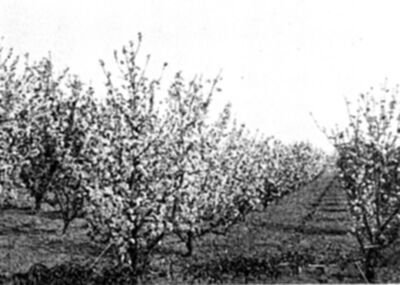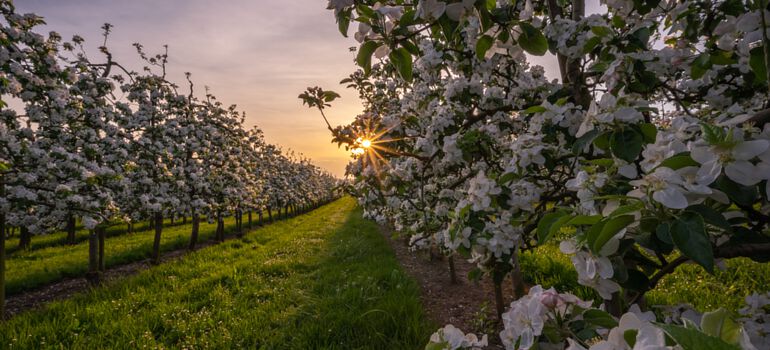While planning for my own permaculture forest garden, I needed to know exactly how far apart to plant my trees. Since the answer isn’t easy to find online, I decided to write a simple, clear explanation of how far to space trees in your orchard.
Standard fruit trees need 18–25 feet minimum, but only 12–15 feet for standard peaches / nectarines. Semi-dwarf verities need 12–15 feet per tree, except sweet cherries which grow up to 18 feet wide. Dwarf fruit trees need about 8–10 feet each. These are absolute minimum spacing requirements.
When planting an orchard, especially a permaculture orchard, there a number of factors including what plant guilds you are using, climate, tree variety, and intended use that all affect how you should space your trees for optimum yield.
Common Permaculture Orchard Tree Spacing Considerations
When planning your permaculture orchard, you end up needing to balance the needs of the system as a whole. While putting trees as close together as possible might seem to maximum productivity, usually trees are given 5–10 feet of extra space beyond the minimum required for planting, in order allow for a number of benefits.
Sunlight & Solar Access
At minimum, it is best that fruit trees are not touching the next fruit tree over.
In commercial orchards, fruits trees are spaced far enough apart, about 5–10 feet between the outermost leaves of the fully grow trees, that the trees are not shaded by their neighbors for the majority of the day.
In permaculture orchards, this ‘extra’ space between the trees, where light falls on the ground part of the day, is filled in with a whole ecosystem of additional plants, called the “tree guild”. (More on this later)

Access & Equipment
Every tree with edible needs some way to approach it from the ground without destroying existing plants. Commercial orchards leave relatively large swaths between tree rows to allow for harvesting equipment access.
Although, for a permaculture orchard this path could be either much smaller, or a row / area previously planted with annual crops that have already died or been harvested before the fruit trees bear.
Generally, for mature highly productive fruit trees, you will also want a larger path capable of supporting wheel barrows, small ATV, or tractor to help move in the very heavy harvest within a short walking distance. Fruit trees tend to produce all at once, so smaller incremental harvests are usually not an option.
Lastly, you will also need to use tall ladders to access standard fruit trees, and to prune them as they grow. This also requires a bit of space between the tree canopy.
Succession Planting
Natural healthy forests generally don’t have just one size or age of tree. For this reason, permaculture orchards choose to intermix trees of various ages.
When planting a young tree in an existing orchard, you may want to plant them close to existing older trees, with the idea that eventually, as the young tree matures, the older tree will die or be removed, making space for it’s replacement.
Mixing Tree Varieties
Permaculture orchards will also often mix fruit trees with other tree and plant verities, or mix different species of fruit tree within the same area of the orchard.
If the trees are plants grow to different overall height, like a apple and plum tree for example, then the shorter trees can be placed nearer to the taller ones on the sunny side. This mimics the multistory canopy, which is found in natural woodland borders. And, it maximizes use of space and productivity.
For more information on getting started with permaculture, check out my articles:
What Are Standard, Semi-Dwarf, and Dwarf?
One really interesting fact about most fruit trees is that they are actually “Siamese twins.” That is, the top and bottom are completely different organisms that are intentionally grown together.
This is a natural farming practice that has been utilized by farmers by hundreds of years.
Most of us are familiar with the different varieties of the top of the tree, which determines the size, shape, and taste of the fruits produced. Granny smith, or pacific rose apples for instance.
On the other hand, the bottom of the tree determines the overall size of the tree, as well as the tree’s immunity to ground borne diseases.
This means a fruit tree can be grown to any particular size, by choosing the correct “root stock.” It also means that just planting an apple seed or fruit tree directly would produce an absurdly large tree when fully mature.
There are many species of root stock available when grafting young seedlings. When buying fruit trees, the nursery should be able to tell you what type they used, and thus how big the tree you bought will end up growing.

Permaculture Forest Guilds
Permaculture orchard design is unique in that it attempts to mix and match plants in a way to boost the resilience and productivity of the entire system.
Unlike traditional orchards, permaculture orchards most often plant trees in groups of other plants called “guilds.” Members of the guilds are chosen to serve one or more of several purposes:
- Attract beneficial insects
- Deter pests and wildlife
- Fertilize / Nitrogen Fix / Mulch
- Suppress grass and weeds
- Prevent excess water loss or soil erosion
- Provide additional edibles or medicinal plants
Likewise, because the process of starting a new orchard can take 5–10 years before fruit trees fully mature, the permaculture forest guilds will also change over time.
One common method is to plant seedlings among nitrogen fixing plants, berries, or other wild ground cover. Then, as the trees grow larger, the soil building plants are cut and mulched in place, providing nutrients to the fruit trees. Eventually, the composition will be changed to the final target plant mixture.
Here are a couple example permaculture orchard plant guilds:
Apple-tree guild
- Red Currant
- Siberian Pea Shrub
- Red and White Clover
- Borage
- Garlic
- Fava Bean
- Dill
- Lupine
- Astragalus
- Native Wildflowers
- Mint
- Basil
Peach-tree guild
- Siberian pea shrub
- Sunflowers
- Cabbage
- Clover
- Comfrey
- Horseradish
- Calendula
- Nicotiana
- Cosmos
These example permaculture orchid guilds are from: Hemenway, Toby. Gaia’s Garden (pp. 325-326). Chelsea Green Publishing. Kindle Edition. Check out this books if you would like a more in depth referent for setting up a permaculture garden, including additional example guilds.
For more examples of productive and pest repellent plants, check out my articles:
- 8 Productive Permaculture Cover Crops
- Ways to Keep Deer Out of the Garden that Actually Work
- Make Fruit Trees Immune to Deer | One Secret You Can’t Miss
Building a “Food Forest” or “Superguild”
Ever increasing in popularity in permaculture design is the concept of a food forest or superguild.
The essence of this idea is that your permaculture orchard / garden should mimic the qualities of a healthy natural forest —
- Many species living in one place, that support each other’s grows
- Each species has a niche (eg overstory, understory, ground) maximizing productivity
- Extremely resilient to disruption, naturally regrowing over time
- Self fertilizing
- Requiring little or no irrigation
The ultimate goal is a garden that produces huge amounts of food, with few inputs, and almost no human intervention.
While there is a lot that can be said about how to accomplish this goal, the basic process is easy to grasp.
- Bring in plants you think would work well together
- Mix everything together
- Observe what does well, and replicate that arrangement
- Cull unproductive areas of the forest, and try again
Currently Edible Forest Gardens is the best resource / reference to learn how to build your own food forest. And, hands down worth the money that they are asking for it.
Check out my recommended permaculture books for my top recommended books, or OGP’s free permaculture article listing for more in depth articles.


